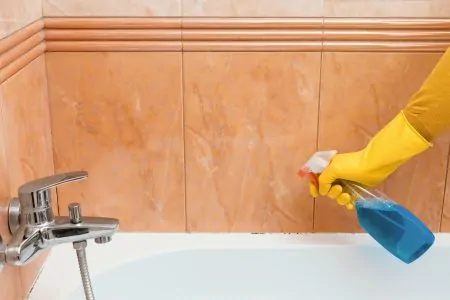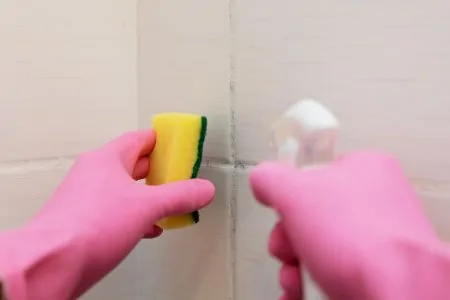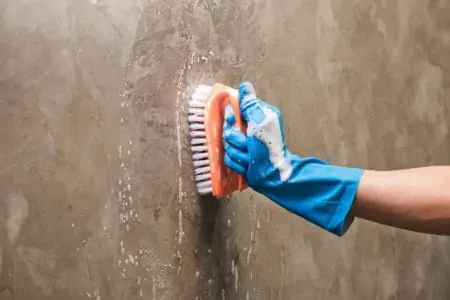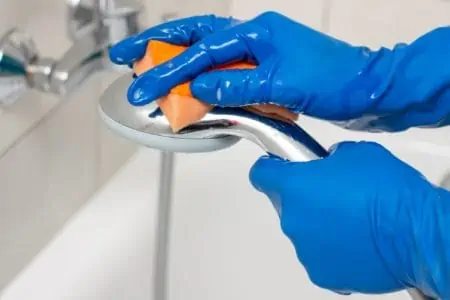The shower is where you go to get clean. But that can only work out if the shower itself is clean. This includes the tub, the walls, the faucets, the shower head and of course, the shower curtain.
When was the last time you cleaned your shower curtain? If you’re struggling to remember, or know the answer is “never”, we’ll show you how to clean shower curtains. From now on, they’ll be sparkling clean, free of mold, dirt and bad odors.
Key Takeaways
- Clean shower curtains in the washing machine with mild detergent or distilled white vinegar, and add towels for protection and agitation.
- Prevent mold by drying the shower curtain after every use and cleaning it regularly, at least every two weeks.
- Hand-washing is an alternative method for cleaning shower curtains, using baking soda and a damp cloth to scrub off dirt and grime.
- Keep shower curtains mold-free by using water-resistant materials and spraying them with a distilled white vinegar solution.
Why Do Shower Curtains Get Moldy?
Most mold is caused by dampness and condensation. After your shower, if you don’t air out or thoroughly dry your shower curtain, it remains wet pretty much all day. This inevitably will lead to mold.
When it comes to preventing mold on shower curtains, our number one tip is to dry your curtain after every use. Instead of leaving it scrunched up after your shower, completely open out the shower curtain — like you would while you’re in the shower — and let it air dry.
Try These
How to Clean Shower Curtains in the Washing Machine
When it comes to washing your shower curtain, there are a few different methods. Firstly — how can you wash the curtains in the machine?
Let’s get into the cleaning method!
1. Remove and Place
Start by removing the shower curtain from the rail. Take off any metal hooks. Then place it into the washing machine. This works for a top or front loading machine.
2. Add Towels
Add two bath towels into the machine with the curtain. These will protect the shower curtain from getting tangled or torn. They agitate the material to remove dirt, grime and other areas of build-up.
Towels also cling to detergent better than plastic, so the towels will provide a deeper clean. Just make sure you’re using clean towels.
3. Add Detergent
Now it’s time for detergent. We recommend choosing a mild detergent, or distilled white vinegar. If using vinegar, add about one cup of distilled white vinegar to the detergent drawer or straight into the drum.
If using detergent, you should add ½ cup of baking soda along with it. This will help remove dirt, grime and kill bad odors.
4. Start the Cycle
For plastics, select the coldest water temperature, at 90°F maximum. For other materials, check the care label, but around 100°F should be fine if in doubt.
Use a gentle cycle to protect the curtain. If you don’t have a gentle cycle, use the hand-wash, wool or baby care cycle. Just make sure you’re able to select the specific temperature.
5. Hang to Dry
When the cycle is finished, hang the curtain back up to dry. Make sure it’s fully open so it gets good airflow. Tumble dry the towels as normal or wash them again.
Is It Safe to Wash a Plastic Shower Curtain in the Washing Machine?
If the care labels allow it, sure. You just need to take a few precautions. For one, don’t use fabric softener as this can damage the plastic.
Always use a low temperature and don’t tumble dry. Finally, add some towels to the wash for extra friction. Otherwise, the detergent won’t be able to grip onto the plastic curtain.
What Temperature Should I Wash My Shower Curtain?
We recommend washing it at a lower washing temperature. High heat can ruin or melt plastic, so we recommend 90°F maximum. If your curtain is made of a different material, check the care label instructions.
How to Clean Shower Curtains by Hand
If you aren’t able to use a machine, or the care label says hand-wash only, that’s great, too!
- Dampen a cloth: Dampen a clean cloth in water.
- Add baking soda: Then sprinkle some baking soda over the cloth. Baking soda is a good natural cleaner. It’s abrasive too, so it can remove dirt and grime.
- Scrub: Use the cloth to scrub down the entire shower curtain. Do not focus on set in stains right now; just tackle the surface-level dirt.
- Rinse: With a separate cloth, dampen it with warm water. Wash down the shower curtain to remove the baking soda solution. Add more water where necessary to remove all baking soda.
- Repeat: Repeat the first three steps again, this time focusing on set-in stains. With the removal of surface-level dirt, this time around, it will be easier to get rid of tougher stains.
- Rinse: Repeat step four, rinsing the shower curtain to remove the baking soda residue.
- Air dry: Fully open the shower curtain and let it air dry. Turn on the extractor fan or open a window to aid this process.
How to Clean Shower Curtain Rings
Now let’s not forget the shower curtain rings — they can get dirty, too! This method works for plastic or metal rings, even if the rings are covered in rust.
- Fill up a basin or sink with warm water and one cup of distilled white vinegar.
- Soak the rings in the solution for a couple of hours.
- Drain the water away and rinse the rings.
- Use a brush to scrub off loose dirt and rust.
- Rinse again.
- Hang them back up.
FAQs
No Mold
With our tips for cleaning your shower curtain, you don’t have to deal with nasty mold again! Simply wash your shower curtain once a month, whether that’s in the machine or by hand.
Prevent mold from growing by spraying the shower curtain with a distilled white vinegar solution. And last but not least, make sure you buy a water-resistant material, such as plastic.












